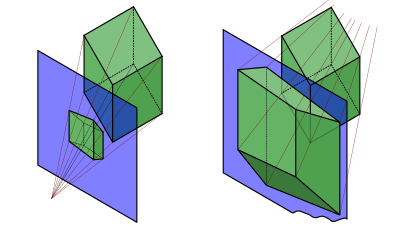

Reverse perspective, also called inverse perspective, inverted perspective, divergent perspective, or Byzantine perspective, is a form of perspective drawing where the objects depicted in a scene are placed between the projective point and the viewing plane. Objects further away from the viewing plane are drawn as larger, and closer objects are drawn as smaller, in contrast to the more conventional linear perspective where closer objects appear larger. Lines that are parallel in three-dimensional space are drawn as diverging against the horizon, rather than converging as they do in linear perspective. Technically, the vanishing points are placed outside the painting with the illusion that they are "in front of" the painting.
The name Byzantine perspective comes from the use of this perspective in Byzantine and Russian Orthodox icons; it is also found in the art of many pre-Renaissance cultures, and was sometimes used in Cubism and other movements of modern art, as well as in children's drawings. The reasons for the convention are still debated among art historians; since the artists involved in forming the convention did not have access to the more realistic linear perspective convention, it is not clear how deliberate the effects achieved were.
References
- ^ Hopkins, Robert (1998), Picture, Image and Experience: A Philosophical Inquiry, Cambridge University Press, p. 157, ISBN 9780521582599.
- Rauschenbach, Boris V. (1983), "On my concept of perceptual perspective that accounts for parallel and inverted perspective in pictorial art", Leonardo, 16 (1): 28–30, doi:10.2307/1575038, JSTOR 1575038, S2CID 192987663.
- ^ Kulvicki, John V. (2006), On Images : Their Structure and Content, Oxford University Press, pp. 102–105, ISBN 9780191537455.
- ^ Howard, Ian P.; Allison, Robert S. (2011), "Drawing with divergent perspective, ancient and modern" (PDF), Perception, 40 (9): 1017–1033, doi:10.1068/p6876, PMID 22208125, S2CID 11085186.
- Deregowski, Jan B.; Parker, Denis M.; Massironi, Manfredo (1994), "The perception of spatial structure with oblique viewing: an explanation for Byzantine perspective?", Perception, 23 (1): 5–13, doi:10.1068/p230005, PMID 7936976, S2CID 16046480.
- Antonova, Clemena (2010), "On the problem of "reverse perspective": definitions east and west", Leonardo, 43 (5): 464–469, doi:10.1162/LEON_a_00039, S2CID 57559265,
The author ... identifies six distinct views on reverse perspective, some of which are mutually exclusive.
- Antonova, Clemena (2010), Space, Time, and Presence in the Icon: Seeing the World with the Eyes of God, Ashgate studies in the history of philosophical theology, Ashgate Publishing, Ltd., p. 54, ISBN 9780754667988,
In the case of "reverse perspective", on the other hand, there is no evidence that icon-painters had recourse to mathematically correct systems of measurement to enable them to represent vanishing point systems"
.
See also
- Telecentric lens (no perspective, all objects the same size at all distances)
- Hypercentric lens (reverse perspective)
External links
- Video demonstrating consistent reverse perspective
- Example of computer generated reverse perspectives
- YouTube video demonstration: "Hypercentric optics: A camera lens that can see behind objects"
- Edmund Optics - Hypercentric Lenses
- YouTube video demonstration transition to reverse perspective and back: "Reverse perspective 3D viewport & render"